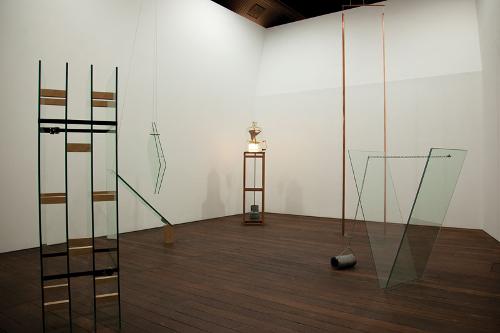.jpg)
When Humphrey Bogart delivered the line: “Here's looking at you kid” it was hardly planned as a pivotal moment in cinematic history. But it struck a chord with generations of filmgoers and came to represent the Zeitgeist of Hollywood during the war years. Consequently, cinema’s most memorable scenes are often not those with the largest production values, but those that find an ongoing resonance in their audience.
The resonating (and often haunting) power of the filmic experience is explored in Dark Matter: Soda_Jerk at the UTS Gallery in Sydney. Soda_Jerk sit in the realm of contemporary artists who work with the great media archive that has amassed over the last century – sampling, splicing and editing to explore the metanarratives and complex relationships that exist between film, time and memory.
The Dark Matter trilogy, presented here in its entirety for the first time, is comprised of three works, The Phoenix Portal (2005), After The Rainbow (2009) and The Time That Remains (2012). Each work (ranging from five to twelve minutes) constructs a narrative from collected scenes and moments sliced from various Hollywood films. The resulting works span lives and careers creating self-reflexive, Möbius loops that play with temporal and ontological space.
The Phoenix Portal mashes River Phoenix as the child actor who appeared in The Explorers (1985), with his adult self, just prior to his tragic death in My Own Private Idaho (1991). Soda_Jerk construct an alternate reality in which both forms of the actor are able to coexist in an enthralling time travel narrative, through editing and compositing sound and film.
After The Rainbow presents a similar narrative in which Judy Garland as a young Dorothy in The Wizard of Oz (1939) is shown visions of her broken-down self in a late 1960s TV variety special. The Time That Remains is a dual screen work featuring Joan Crawford and Bette Davis in a looping duet of unsettled sleep. The work samples multiple film appearances and creates a narrative of unsettled sleep, clarifying the links between dreams and the ontological space of film.
Christian Marclay’s The Clock (2010) was an international success because it was one of the first works to successfully tap into the great freight of collective memory that is united under cinematic history. Dark Matter certainly doesn’t operate on the same scale as The Clock, but it does push the conceptual framework that allows narratives to spill across filmic history.
The Clock suggested that audiences could experience thousands of disparate film scenes collectively by amalgamating those fragments of film and relating them to their own memories and experience. Seemingly mundane or disparate scenes were edited together to suggest a complex network of narratives. Dark Matter ties these strands together in order to crystallise the suggestions made in Marclay’s work, by offering complex but nevertheless resolved narratives.
Damaged film excerpts remind us of one of the central tensions at play in these works: the transience and the immortality of the Hollywood star system.
The sound editing is a real success, and it was a shame that only two of the works provided headphones that allowed them to be heard properly (the third played quietly through sub-standard speakers).
The three works are all successful entities unto themselves and the collective exhibition only strengthens them. However it should be noted that the text accompanying the works is exhaustively clever in its musings on the conceptual frameworks behind them. This writing does reveal the time, effort and research that has gone into each work, but its inclusion is questionable, as this investment is self-evident in the final productions.
Dark matter refers to a type of matter that cannot be perceived directly, rather its presence is only inferred through the gravitational force it exerts on other objects. As a scientific concept, dark matter is impressive and affecting precisely because it cannot be explained, because of the mystery it presents. Soda_Jerk has created works which do just that, and if you ignore the explanations you’ll tap into some of the mystery of the filmic experience that resonates with us all.












